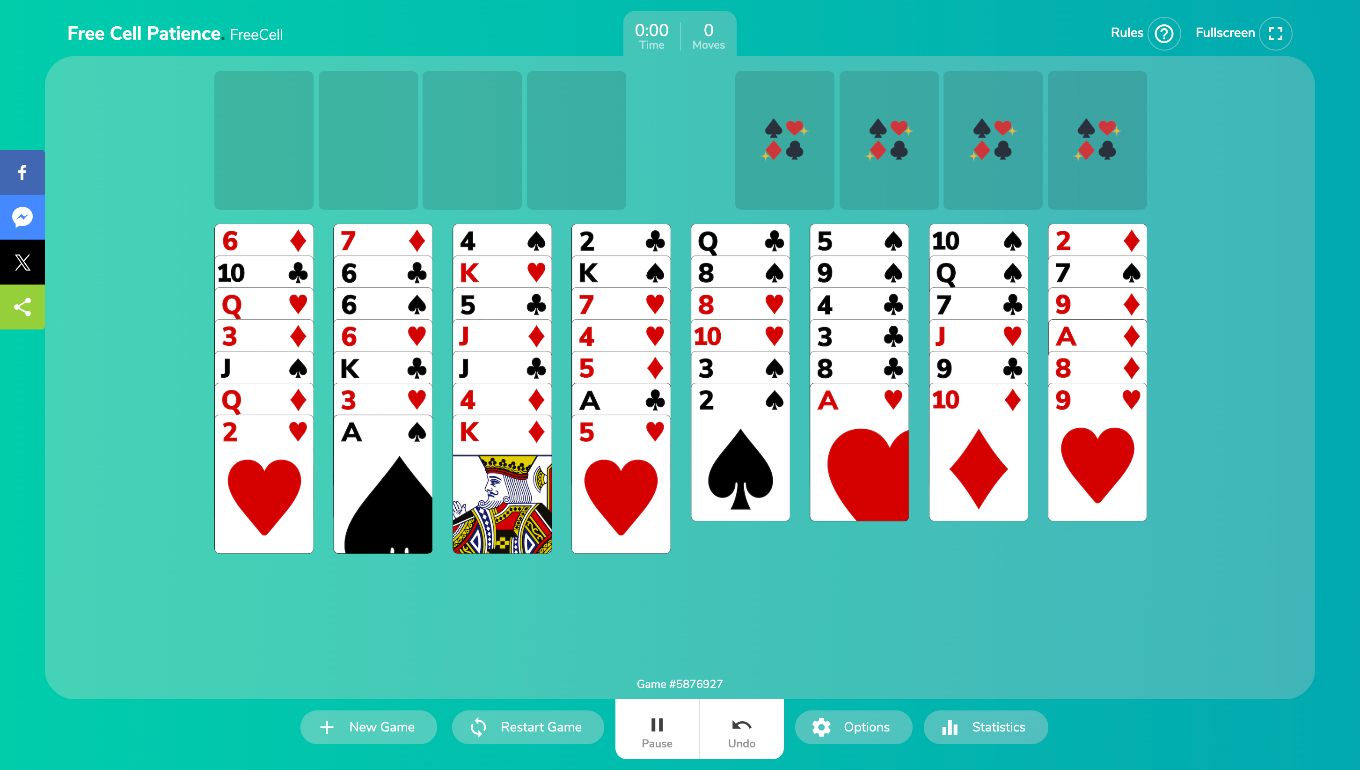FREE CELL PATIENCE

Frequently Asked Questions
-
What is Free Cell Patience and how is it different from other solitaire games?
Free Cell Patience is a strategic solitaire card game where all 52 cards are dealt face-up from the beginning, making it a game of pure skill rather than luck. It features four free cells for temporary card storage and nearly 99.999% of games are solvable with perfect play. Unlike Klondike or other solitaire variants, you can see every card from the start and plan your complete strategy.
-
How do you play Free Cell Patience - what are the basic rules?
The goal is to move all cards to four foundation piles from Ace to King by suit. Cards are dealt into 8 tableau columns (first 4 have 7 cards, last 4 have 6 cards). Build tableau sequences in descending order with alternating colors. Use four free cells to temporarily store single cards. You can move sequences equal to (empty free cells + 1) × 2^(empty columns).
-
How many cards can you move at once in Free Cell Patience?
You can move cards equal to (empty free cells + 1) × 2^(empty columns). With 4 empty free cells and no empty columns, you can move 5 cards. With 2 empty free cells, you can move 3 cards. Each empty column doubles your capacity. For example, 4 free cells + 1 empty column = 10 cards movable.
-
Can all Free Cell Patience games be won?
Almost all games are winnable - approximately 99.999% are solvable with perfect strategy. Only about 1 in 84,000 deals are impossible. The most famous unsolvable deal is Microsoft FreeCell game #11982. Average players win 35-45% due to strategic errors, while experts achieve 80-95% win rates.
-
What are the best strategies for winning Free Cell Patience?
Key strategies: 1) Survey the entire tableau before moving, 2) Prioritize freeing Aces, 2s, and 3s immediately, 3) Keep at least one free cell empty when possible, 4) Create empty columns early for maximum flexibility, 5) Build foundation piles evenly, 6) Think 3-5 moves ahead, 7) Avoid building sequences longer than you can move, 8) Use undo feature to explore alternatives.
-
What are the free cells and how do they work in Free Cell Patience?
Free cells are four empty spaces in the top-left corner where you can temporarily store any single exposed card. They act as tactical parking spaces to help access buried cards and execute complex moves. Each free cell holds only one card at a time. The number of empty free cells directly affects how many sequential cards you can move together.
-
Where can I play Free Cell Patience online for free?
You can play Free Cell Patience completely free at free-cell-patience.com with no download, registration, or payment required. The game works on all devices including desktop, tablet, and mobile. Features include unlimited games, statistics tracking, undo feature, hints, and a clean distraction-free interface optimized for both casual and expert players.
-
What is a supermove in Free Cell Patience?
A supermove is moving a sequence of properly ordered cards by using free cells and empty columns as temporary storage. The computer automatically handles the complex series of individual card movements required, making it appear as one smooth action. This technique is essential for efficiently moving longer sequences and is calculated based on available free cells and empty columns.
-
Is Free Cell Patience good for brain training and cognitive health?
Yes, Free Cell Patience offers excellent cognitive benefits including improved strategic thinking, enhanced memory, better problem-solving skills, increased focus and concentration, stress reduction, and patience development. Research from the Oregon Center for Aging & Technology found it can help identify memory problems. The game exercises visual memory, sequential thinking, and analytical reasoning.
-
What are the most common mistakes beginners make in Free Cell Patience?
Common mistakes include: 1) Filling all four free cells too quickly, leaving no room to maneuver, 2) Not planning ahead before making moves, 3) Building sequences longer than you can actually move, 4) Ignoring the power of empty columns, 5) Rushing to move cards to foundations when they're still useful in tableau, 6) Using free cells randomly without strategy, 7) Not using the undo feature to explore alternatives, 8) Building foundation piles unevenly, 9) Placing Kings in empty columns too early, 10) Giving up on solvable games too soon.
-
How long does it take to play a game of Free Cell Patience?
Average game time is 5-15 minutes depending on difficulty and player skill. Easy deals can be solved in under 2 minutes, while complex games may take 20-30+ minutes. Expert players who plan strategically often complete games faster than beginners. The game rewards thoughtful planning over rushed moves, so taking time to analyze the tableau improves win rates.
-
What's the difference between Free Cell Patience and Klondike Solitaire?
Free Cell Patience has all cards face-up from the start, making it 99.999% solvable through skill. Klondike has cards face-down, relies heavily on luck (~30%), and only ~79% of games are winnable. Free Cell uses 4 free cells for tactical storage, while Klondike uses a stock pile. Free Cell requires more strategic planning, while Klondike is faster and more casual.
-
Can I undo moves in Free Cell Patience?
Yes! Most online Free Cell Patience games offer unlimited undo functionality. Using undo is encouraged as a learning tool to explore different strategies, test move sequences, and find optimal solutions. Expert players regularly use undo to analyze alternatives without penalty. It's an essential feature for improving your skills and win rate.
-
Are there different variations of Free Cell Patience?
Yes, popular variations include: Baker's Game (build by suit instead of alternating colors), Eight Off (8 free cells with 4 pre-filled), Seahaven Towers (10 columns and 2 free cells), ForeCell (3 free cells for higher difficulty), Double FreeCell (uses 2 decks with 104 cards), and Relaxed FreeCell (unlimited sequence moves). Each variation offers unique strategic challenges.
-
Why do I keep losing at Free Cell Patience?
Common reasons for losses: 1) Making moves without planning ahead, 2) Filling all free cells too early, 3) Not creating empty columns, 4) Building sequences that are too long to move, 5) Not prioritizing low cards (Aces, 2s, 3s), 6) Random rather than strategic free cell usage. Study the strategies, use the undo feature extensively, practice on the same numbered deals, and analyze your losing games to identify patterns.
-
Is Free Cell Patience harder than Spider Solitaire?
Difficulty is comparable but different. Free Cell requires more strategic planning since all cards are visible, demanding careful calculation of move sequences. Spider Solitaire involves more cards and suits but includes hidden cards. Free Cell has higher solvability (99.999% vs ~90%), making consistent wins more achievable with skill. Most players find Free Cell more intellectually challenging but less frustrating than Spider.
-
Do I need to register or pay to play Free Cell Patience online?
No registration, payment, download, or subscription is required to play Free Cell Patience online at free-cell-patience.com. The game is 100% free with unlimited plays, works on all devices (desktop, tablet, mobile), includes full features like statistics tracking and undo, and has no hidden fees or premium tiers. Just visit and start playing immediately.
-
What does it mean when a Free Cell Patience game is unsolvable?
An unsolvable game is one where no sequence of legal moves can result in victory, no matter how perfectly you play. Only about 1 in 84,000 random deals is truly impossible. Microsoft FreeCell game #11982 is the most famous example. If you're stuck, use undo extensively and try different approaches before concluding a game is unsolvable - most apparent dead-ends have solutions you haven't discovered yet.
-
How do empty columns help in Free Cell Patience?
Empty columns are your most powerful tool in Free Cell Patience. They double your card-moving capacity by acting like super-powered free cells. With 4 free cells + 1 empty column, you can move 10 cards instead of 5. Empty columns can hold any card or sequence, providing maximum flexibility for reorganizing the tableau. Creating empty columns early should be a top strategic priority.
-
Should I always move Aces to the foundation immediately?
Yes, always move Aces to foundations immediately - they provide no strategic value in the tableau. Same for 2s once their Ace is placed, and usually 3s and 4s. However, keep higher cards (especially 8-King) in the tableau if they're helping build sequences or access buried cards. Don't rush to move cards to foundations if they're still tactically useful in gameplay.

